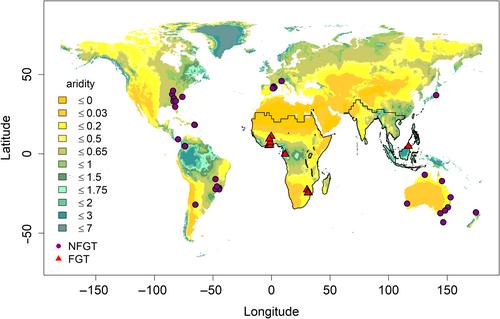Biogeographical Variation in Termite Distributions Alters Global Deadwood Decay
Abstract
Aim
Termites are a crucial group of macroinvertebrates regulating rates of deadwood decomposition across tropical and subtropical regions. When examining global patterns of deadwood decay, termites are treated as a homogenous group. There exist key biogeographical differences in termite distribution. One such clear distinction is the distribution of fungus-growing termites (FGT, subfamily Macrotermitinae). Considering that climate will have shaped termite distribution and ecosystem processes, we evaluate the roles of termite distribution (presence of FGT) and climate (aridity) on global patterns in deadwood decay.
Location
Between 46° N-43° S and 175° E-85° W.
Time Period
Present (between 2016 and 2021).
Major Taxa Studied
Termites (Blattodea: Termitoidae).
Methods
We add salient data to an existing global dataset on deadwood decomposition, including new data from five existing sites and seven additional African sites. We analyse a dataset spanning six continents, 16 countries and 102 experimental sites. Firstly, we evaluate climatic differences (mean annual temperature, mean annual precipitation and mean annual aridity) between sites with and without FGT. Secondly, using aridity as a single comparative climate metric between sites that accounts for temperature and precipitation differences, we examine the interaction between FGT and aridity on global patterns of termite deadwood discovery and decay through multivariate logistic and linear regressions.
Results
Termite-driven decay and wood discovery increased with aridity; however, responses differed between FGT and NFGT sites. Wood discovery increased with aridity in FGT sites only, suggesting a greater role of FGT to deadwood decay in arid environments. On average, both termite discovery and decay of deadwood were approximately four times greater in regions with FGT compared with regions without FGT.
Main Conclusions
Termite discovery and decay of deadwood is climate dependent, and higher decay may be through greater discovery of deadwood in FGT sites. Inclusion of biogeographical differences in termite distribution could potentially alter current and future global estimates of deadwood turnover.


 求助内容:
求助内容: 应助结果提醒方式:
应助结果提醒方式:


